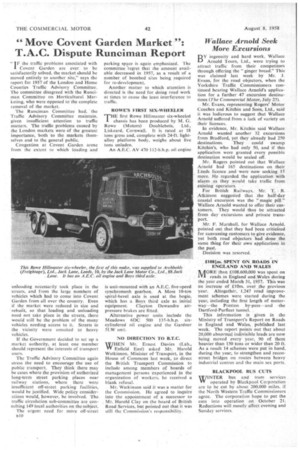"Move Covent Garden Market ": T.A.C. Dispute Runciman Report
Page 44

If you've noticed an error in this article please click here to report it so we can fix it.
"
IF the traffic problems associated with Covent Garden are ever to be satisfactorily solved, the market should be moved entirely to another site," says the report for 1957 of the London and Home Counties Traffic Advisory Committee, The committee disagreed with the Runciman Committee on Horticultural Marketing, who were opposed to.the complete removal of the market.
The Runciman Committee had, the Traffic Advisory Committee maintain, given insufficient attention to traffic matters. The traffic problems caused by the London markets were of the greatest importance, both to the markets themselves and to the general public.
. Congestion at Covent Garden arose from the extent to which loading and
unloading necessarily took place in the streets, and from the large numbers of vehicles which had to come into Covent Garden from all over the country. Even if the market were reduced in size and rebuilt, so that loading and unloading need not take place in the streets, there would still be the problem of the many vehicles needing access to it. Streets in the vicinity were unsuited to heavy vehicles.
If the Government decided to set up a market authority, at least one member should represent the interests of transport users.
The Traffic Advisory Committee again stress the need to encourage the use of public transport. They think there may be cases where the provision of authorized long-term street Parking places near railway stations, where there were insufficient off-street parking facilities, would be justified. Wide policy considerations would, however, be involved. The. traffic circulation sub-committee are consulting 149 local authorities on the subject.
The urgent need for more off-street
11 i 0
parking space is again emphasized. The committee regret that the amount available decreased in 1957, as a result of a number of bombed sites being required for re-development.
Another matter to which attention is directed is the need for doing road work at times to cause the least interference to traffic.
ROWE'S FIRST SIX-WHEELER THE first Rowe Hillmaster six-wheeled chassis has been produced by M. G. Rowe (Motors) Doublebois, -Ltd., Liskeard, Cornwall. It is rated at 18 tons gross and, complete with 244t. lightalloy platform body, weighs about five
tons unladen. .
An A.E.C. AV 470 112-h.h.p. oil engine is unit-mounted with an A.E.C. five-speed synchromesh gearbox. A Moss 10-ton spiral-bevel axle is used at the bogie, which has a Boys third axle as initial equipment. Clayton Dewandre airpressure brakes are fitted.
Alternative power units include the Meadows 60C 500 135-b.h.p. sixcylindered oil engine and the Gardner 5LW unit,
NO DIRECTION TO B.T.C. WHEN Mr. Ernest Davies (Lab., VI' Enfield East) asked Mr. Harold Watkinson, Minister of Transport, in the House of Commons last week, to direct the British Transport Commission to include among members of boards of management persons experienced in the organization of workers, he received a blank refusal.
Mr. Watkinson said it was a matter for the Commission. He agreed to inquire into the appointment of a successor to Mr. Harold Clay on the board of British Road Services, but pointed out that it was still the Commission's responsibility.




































































































